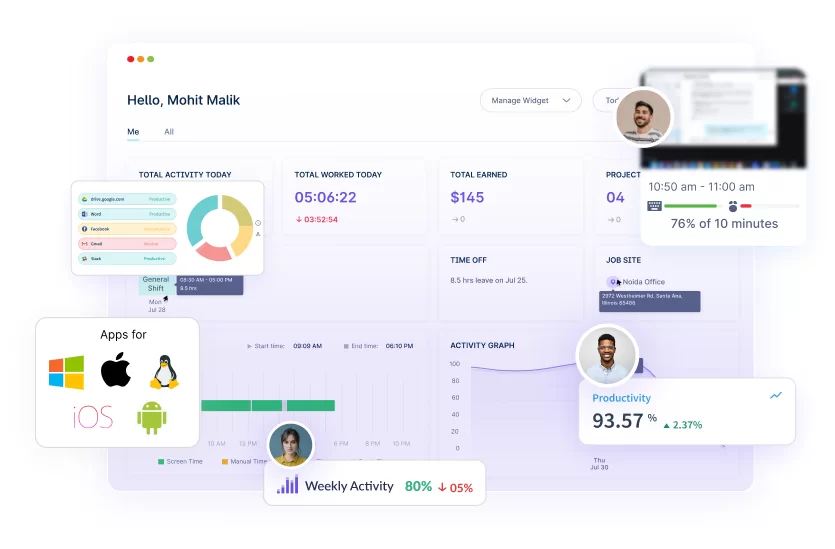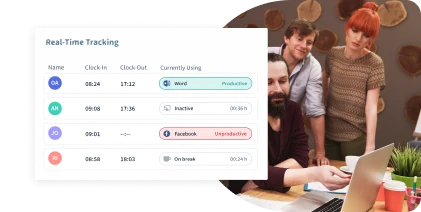Table of Contents
Mastering time management is essential for achieving productivity and success.
However, 41% of organizations still need to learn the art of mastering time management.
As a result, they most often find themselves dealing with the following challenges:
- Inaccurate project estimations
- Poor customer service
- No innovation and growth
- Increased costs
- Missed deadlines
Are you looking for a more productive workplace?
This blog post will explore some tremendous productive activities that will let you gain control over your schedule and deadlines and make the most of your valuable time.
Discover how innovative tools like Workstatus can transform your work, ensuring you make the most of every moment.

Let’s dive in:
11 Things To Master Time Management
Here are the top productive things that you can follow to master the art of time management:
Plan Your Day
Planning your day can significantly boost productivity.
Consider these tips:
- Start your day by creating a detailed schedule or to-do list
- Break down larger tasks into smaller, manageable subtasks
- Allocate specific time slots for each task, ensuring a realistic timeframe
- Set realistic goals for the day and track your progress
- Use digital tools or apps to organize and visualize your schedule effectively
Prioritize Your Tasks
Effectively prioritizing your tasks is crucial for effective time management.
Consider the following strategies:
- Identify urgent and essential tasks and prioritize them accordingly
- Use the Eisenhower Matrix (quadrants of urgency and importance) to categorize tasks
- Create a to-do list and rank tasks based on their priority level
- Focus on high-value activities that align with your goals and yield significant results
- Regularly reassess and adjust priorities as needed
Workstatus can assist you in this process through its features and capabilities:
Task Management: Get a centralized platform to create, assign, and track tasks. You can prioritize tasks based on urgency, importance, or deadlines.
Task Dependencies: You can establish task dependencies to ensure a logical sequence of work. It helps you focus on high-priority tasks without being overwhelmed by less critical ones.
Add Tasks Notes: Workstatus lets you add task notes, making it easier to categorize and prioritize them. You can also create notes such as “urgent,” “important,” or “high-priority” to highlight tasks that require immediate attention.

Practice Time Blocking
Time blocking involves dedicating specific blocks of time for focused work on specific tasks or activities.
Here’s how to implement it effectively:
- Identify your most productive hours and allocate them for important, focused work
- Create designated blocks for specific activities like meetings, emails, or brainstorming
- Minimize distractions during time blocks by turning off notifications or using productivity apps
- Take short breaks between time blocks to rejuvenate and maintain focus
Time blocking involves allocating dedicated time slots for specific tasks or activities.
Workstatus offers features that support effective time blocking:
Calendar Integration: Workstatus integrates with your calendar, allowing you to block time directly from your schedule. You can assign specific tasks or activities to time slots, ensuring focused work during those periods.
Time Tracking: Time block or track the time spent on each task to get accurate insights into your productivity and adherence to the allocated time.
Notifications and Reminders: You can send notifications or reminders when it’s time to transition to a different task or time block. It helps you to maintain discipline in following your schedule.

Eliminate Time Wasters
Identifying and eliminating time-wasting activities is vital for efficient time management.
Consider the following steps:
- Identify common time wasters like excessive social media usage, unnecessary meetings, or unproductive conversations
- Set boundaries and establish rules to limit time spent on non-essential activities
- Delegate or automate tasks whenever possible
- Optimize workflow processes to eliminate bottlenecks and streamline efficiency
- Regularly review your work habits and identify areas where time is being wasted.
Delegate and Outsource
Delegating tasks and outsourcing non-essential activities can free up valuable time for high-priority work.
Consider these strategies:
- Identify tasks that can be effectively delegated to team members or outsourced to external resources
- Communicate expectations, deadlines, and desired outcomes when delegating
- Trust your team members’ abilities and provide the necessary support and guidance
- Utilize freelancers or outsourcing services for tasks outside your expertise or time constraints
- Regularly review and assess the effectiveness of delegation and outsourcing efforts
Delegating tasks is a crucial aspect of time management.
Workstatus facilitates effective delegation and collaboration among team members through its collaborative features:
Task Assignment: With Workstatus, you can assign tasks to specific team members, clearly defining responsibilities and deadlines.
Task Comments and Discussions: Get a platform for team members to communicate and discuss tasks. It enables effective collaboration, reduces the need for time-consuming meetings, and ensures everyone is on the same page.
Progress Tracking: Workstatus lets you track the progress of delegated tasks, ensuring accountability and timely completion. You can monitor task statuses, review updates, and intervene if needed.

Learn to Say No
Saying no to non-essential commitments is essential for protecting your time and energy.
Consider these suggestions:
- Assess the importance and alignment of requests with your goals and priorities
- Be polite yet assertive in declining requests that don’t align with your current workload or objectives
- Set boundaries and communicate your availability and limitations clearly
- Focus on your commitments and avoid overextending yourself
- Prioritize your well-being and maintain a healthy work-life balance
Take Breaks and Practice Self-Care
Taking regular breaks and practicing self-care are vital for maintaining focus and productivity.
Consider these self-care strategies:
- Take short breaks between tasks or time blocks to recharge and avoid burnout
- Engage in physical activities or mindfulness exercises to clear your mind and reduce stress
- Prioritize sleep, nutrition, and exercise to enhance overall well-being
- Step away from work and pursue hobbies or activities that bring you joy
- Remember, self-care is an investment in your long-term productivity and success
Optimize Your Environment
Creating an environment conducive to productivity can significantly impact your time management.
Consider these tips:
- Organize your physical workspace to minimize clutter and distractions
- Set up a comfortable and ergonomically designed work area
- Customize your digital workspace for efficiency, using productivity tools or software
- Minimize interruptions by establishing boundaries and communication protocols
- Surround yourself with positive influences and eliminate negativity from your work environment
Learn Time Management Techniques
Explore various time management techniques to find what works best for you.
Consider these popular techniques:
a. Pomodoro Technique
Work for a set amount of time (e.g., 25 minutes) followed by a short break.
Workstatus helps you adhere to the Pomodoro Technique’s work and break intervals.
You can set timers, track your focused work sessions, and take breaks accordingly.
b. Eat the Frog
Tackle the most challenging task should be first thing in the morning.
Workstatus tracks the time spent on each task, allowing you to measure your progress and ensure you dedicate enough time to tackle the frogs.
c. The 80/20 Rule (Pareto Principle)
Focus on the 20% of tasks that yield 80% of the results.
Workstatus provides detailed analytics and reports on time spent on tasks, projects, or clients.
It helps you identify the tasks that contribute the most to your results.
d. Eisenhower Matrix
You can use Workstatus’s task labels or tags to categorize tasks based on their urgency and importance, aligning with the principles of the Eisenhower Matrix.
It helps you prioritize tasks effectively and manage your time accordingly.
Evaluate and Adjust
Regularly evaluating and adjusting your time management strategies is essential for continuous improvement.
Consider these actions:
- Reflect on your daily, weekly, and monthly performance
- Assess the effectiveness of your time management techniques and practices
- Seek feedback from colleagues or mentors to gain different perspectives
- Make necessary adjustments to your routines, schedules, or strategies
Seek Continuous Learning
Embracing a mindset of continuous learning is crucial for mastering time management.
Consider these suggestions:
- Stay updated on the latest productivity tools, techniques, and best practices
- Read books, articles, or blogs on time management and personal productivity
- Attend webinars, workshops, or conferences on time management
- Seek inspiration and insights from successful individuals known for their time management skills
- Experiment with new approaches and adapt them to fit your unique work style
Closing Thoughts
Mastering time management is a key skill for achieving productivity and success.
By implementing the 11 productive strategies discussed in this blog, you can take control of your time, increase efficiency, and reduce stress, ultimately leading to greater accomplishments and a better work-life balance.
FAQs
Q. How can I prioritize my tasks effectively?
Ans. Prioritize tasks based on urgency and importance, utilizing techniques like the Eisenhower Matrix or task labeling.
Q. What is the best way to avoid procrastination?
Ans. Break tasks into smaller, manageable chunks and set clear deadlines to overcome procrastination tendencies.
Q. How can I handle interruptions and distractions?
Ans. Minimize distractions by setting boundaries, turning off notifications, and utilizing time-blocking techniques to maintain focus.









